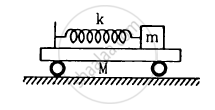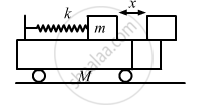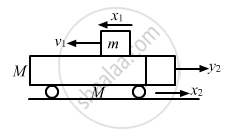Advertisements
Advertisements
प्रश्न
All the surfaces shown in figure are frictionless. The mass of the care is M, that of the block is m and the spring has spring constant k. Initially the car and the block are at rest and the spring is stretched through a length x0 when the system is released. (a) Find the amplitudes of the simple harmonic motion of the block and of the care as seen from the road. (b) Find the time period(s) of the two simple harmonic motions.

उत्तर
Let x1 and x2 be the amplitudes of oscillation of masses m and M respectively.
(a) As the centre of mass should not change during the motion, we can write:
mx1 = Mx2 \[\ldots(1)\]
Let k be the spring constant. By conservation of energy, we have:
\[\frac{1}{2}k x_0^2 = \frac{1}{2}k \left( x_1 + x_2 \right)^2 \ldots(2)\]
where x0 is the length to which spring is stretched.
From equation (2) we have,
\[x_0 = x_1 + x_2 \]
On substituting the value of x2 from equation (1) in equation (2), we get:
\[x_0 = x_1 + \frac{m x_1}{M}\]
\[ \Rightarrow x_0 = \left( 1 + \frac{m}{M} \right) x_1 \]
\[ \Rightarrow x_1 = \left( \frac{M}{M + m} \right) x_0\]
\[\text { Now }, x_2 = x_0 - x_1 \]
On substituting the value of x1 from above equation, we get:
\[\Rightarrow x_2 = x_0 \left[ 1 - \frac{M}{M + m} \right]\]
\[ \Rightarrow x_2 = \frac{m x_0}{M + m}\]
Thus, the amplitude of the simple harmonic motion of a car, as seen from the road is

Let v1 and v2 be the velocities.
Using law of conservation of energy we have,
Now, from the principle of conservation of momentum, we have:
Mx2 = mx1
\[\Rightarrow x_1 = \left( \frac{M}{m} \right) x_2 . . . . \left( 4 \right)\]
\[M v_2 = m\left( v_1 - v_2 \right)\]
\[ \Rightarrow \left( v_1 - v_2 \right) = \left( \frac{M}{m} \right) v_2 . . . . \left( 5 \right)\]
Putting the above values in equation (3), we get:
\[\frac{1}{2}M v_2^2 + \frac{1}{2}m\frac{M^2}{m^2} v_2^2 + \frac{1}{2}k x_2^2 \left( 1 + \frac{M}{m} \right)^2 = \text { constant }\]
\[ \therefore M\left( 1 + \frac{M}{m} \right) v_2^2 + k\left( 1 + \frac{M}{m} \right) x_2^2 = \text { constant } \]
\[ \Rightarrow M v_2^2 + k\left( 1 + \frac{M}{m} \right) x_2^2 = \text { constant } \]
Taking derivative of both the sides, we get:
\[M \times 2 v_2 \frac{d v_2}{dt} + k\left( \frac{M + m}{m} \right)2 x_2 \frac{d x_2}{dt} = 0\]
\[ \Rightarrow m a_2 + k\left( \frac{M + m}{m} \right) x_2 = 0 \left[ \text { because }, v_2 = \frac{d x_2}{dt} \right]\]
\[\frac{a_2}{x_2} = \frac{- k\left( M + m \right)}{Mm} = \omega^2 \]
\[ \therefore \omega = \sqrt{\frac{k\left( M + m \right)}{Mm}}\]
\[\text { Therefore, time period }, T = 2\pi\sqrt{\frac{Mm}{k\left( M + m \right)}}\]

APPEARS IN
संबंधित प्रश्न
Show variation of displacement, velocity, and acceleration with phase for a particle performing linear S.H.M. graphically, when it starts from the extreme position.
A block of known mass is suspended from a fixed support through a light spring. Can you find the time period of vertical oscillation only by measuring the extension of the spring when the block is in equilibrium?
The time period of a particle in simple harmonic motion is equal to the smallest time between the particle acquiring a particular velocity \[\vec{v}\] . The value of v is
The displacement of a particle in simple harmonic motion in one time period is
A particle moves on the X-axis according to the equation x = A + B sin ωt. The motion is simple harmonic with amplitude
Which of the following quantities are always negative in a simple harmonic motion?
(a) \[\vec{F} . \vec{a} .\]
(b) \[\vec{v} . \vec{r} .\]
(c) \[\vec{a} . \vec{r} .\]
(d)\[\vec{F} . \vec{r} .\]
A particle moves on the X-axis according to the equation x = x0 sin2 ωt. The motion is simple harmonic
A particle executes simple harmonic motion with an amplitude of 10 cm and time period 6 s. At t = 0 it is at position x = 5 cm going towards positive x-direction. Write the equation for the displacement x at time t. Find the magnitude of the acceleration of the particle at t = 4 s.
A pendulum having time period equal to two seconds is called a seconds pendulum. Those used in pendulum clocks are of this type. Find the length of a second pendulum at a place where g = π2 m/s2.
The pendulum of a certain clock has time period 2.04 s. How fast or slow does the clock run during 24 hours?
Assume that a tunnel is dug across the earth (radius = R) passing through its centre. Find the time a particle takes to cover the length of the tunnel if (a) it is projected into the tunnel with a speed of \[\sqrt{gR}\] (b) it is released from a height R above the tunnel (c) it is thrown vertically upward along the length of tunnel with a speed of \[\sqrt{gR}\]
A simple pendulum of length l is suspended through the ceiling of an elevator. Find the time period of small oscillations if the elevator (a) is going up with and acceleration a0(b) is going down with an acceleration a0 and (c) is moving with a uniform velocity.
A simple pendulum of length 1 feet suspended from the ceiling of an elevator takes π/3 seconds to complete one oscillation. Find the acceleration of the elevator.
A uniform rod of length l is suspended by an end and is made to undergo small oscillations. Find the length of the simple pendulum having the time period equal to that of the road.
A hollow sphere of radius 2 cm is attached to an 18 cm long thread to make a pendulum. Find the time period of oscillation of this pendulum. How does it differ from the time period calculated using the formula for a simple pendulum?
A particle is subjected to two simple harmonic motions of same time period in the same direction. The amplitude of the first motion is 3.0 cm and that of the second is 4.0 cm. Find the resultant amplitude if the phase difference between the motions is (a) 0°, (b) 60°, (c) 90°.
The length of a second’s pendulum on the surface of the Earth is 0.9 m. The length of the same pendulum on the surface of planet X such that the acceleration of the planet X is n times greater than the Earth is
If the inertial mass and gravitational mass of the simple pendulum of length l are not equal, then the time period of the simple pendulum is
Write short notes on two springs connected in series.
